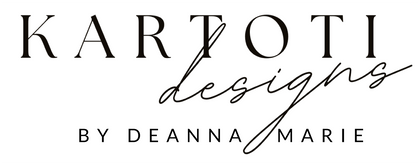You can’t pitch if you don’t know who to pitch to. That was my biggest hurdle when I first started out. I had a growing portfolio, ideas that just wouldn’t quit—and zero clue who might want my art on their products.
Sound familiar?
If you're in that same boat, wondering how to actually find the right companies to pitch your surface pattern designs to, this post is for you. Below are the exact methods I’ve used (and still use) to uncover great leads, do my homework, and build a growing pitch list of dream clients.
Let’s dig in.
1. Product Flip (My OG Method!)
This is how I started out—and honestly, I still do it all the time.
Next time you're in a boutique, bookstore, or gift shop, flip those products over. See a journal, candle, tea towel, or wrapping paper with artwork that resonates with you? Turn it around, snap a quick pic of the tag or bottom of the packaging—anything that shows the brand name, website, or info.
Then, when you're home, look up the company online and see if they license art or collaborate with designers. It's such a simple practice, but it's helped me discover some of my best leads over the years.
2. Scroll Smarter on Instagram
You already scroll. Let’s make it strategic.
Search hashtags like:
-
#stationerybrand
-
#smallshoplove
-
#giftwrapdesign
-
#supportsmallbusiness
-
#patternedproducts
-
#boutiquefinds
-
#artisandesign
-
#surfacepatterndesign
When something catches your eye—check the brand. Do they sell products that feature art or patterns? If yes, follow the trail to their website and look for any art submission info (sometimes buried in the FAQ or contact page).
3. Search Online for “Art Submissions”
Sometimes a little keyword search goes a long way.
Hop on Google and try searching:
-
stationery with florals
-
tea towels with patterns
-
wrapping paper with watercolor designs
-
journals with hand-drawn covers
-
wall art from independent artists
-
Or any product you think your work would look great on.
You’d be surprised how many brands have submission portals or call-outs listed—you just have to do a little digging.
4. Visit Boutiques—Locally and When You Travel
Grab a tea and take yourself on a research date.
Head to a few local gift shops or boutiques in your area—or make it a fun habit when you’re traveling! I love checking out small shops while on vacation and doing a little visual recon while I browse.
Flip the products over. Snap photos of anything you love. Many boutique-friendly brands are open to licensing or collaborations—especially if they’re smaller and still growing.
Bonus: you’ll get a sense of the kinds of designs that are trending in your niche and discover potential stockists too.
5. Pinterest as a Visual Search Engine
Pinterest isn’t just for dinner recipes or home inspo—it’s a goldmine for spotting product-based companies.
Search terms like:
-
“Art prints for gallery walls”
-
“Floral wrapping paper”
-
“Colorful journals”
-
“Cute notebooks for gifts”
-
Or even products you’d love to see your artwork on
Pay attention to the brand names linked in the pins. Follow the trail to their website and find out if they license art or feature artists. If they do—add them to your pitch list.
6. Use LinkedIn to Find Contacts
This is a quieter one, but super useful: look up company names and find art directors or creative leads on LinkedIn.
Even if you don’t connect right away, it helps to know who might be making decisions about artwork. Sometimes, a bit of digging can get you an email or point you in the right direction for submissions.
7. Check the Website (Yes, Really Check It)
Not every brand makes it obvious whether they accept submissions—but don’t let that stop you.
Go beyond the homepage. Look at:
-
FAQ pages
-
Contact or “About” pages
-
Careers or team sections
-
Footers with small links
If you still can’t find anything, it's absolutely okay to send an email to the general inbox asking if they accept art submissions. Keep it short and kind. I’ve created a set of email templates you can use as a starting point—scroll down for the link to grab them.
8. Slide Into Their DMs (the Friendly Kind)
When all else fails, a quick, kind message on Instagram can go a long way.
If a brand’s website doesn’t mention submissions, and there’s no contact for their art department, I’ll message them with something like:
“Hi! I’m a surface pattern designer and I love your product line. Do you accept artwork submissions? If so, who can I forward my portfolio to?”
That one little message has opened some wonderful doors for me.
9. Keep a Master Tracking Sheet
As you gather names, keep them organized. I started with a Google Sheet and eventually moved to a CRM called Google Streak.
In your tracking sheet, include:
-
Company name
-
Website and Instagram
-
Product categories
-
Contact person and/or email (if you have it)
-
Notes about their aesthetic
-
Date you sent your pitch
-
Follow-up reminders
This one step will make future pitching so much easier—you’ll never forget who you contacted, when, or what the reply was.
Final Thoughts
There’s no one “right way” to find companies. The key is to stay curious, stay consistent, and always keep your eyes open for inspiration—whether you’re browsing online or flipping over a product in a cute little shop.
And when you do find the right brand? Make sure you’re ready to reach out with confidence. (I’ve got you covered with my email templates for that—link below.)
You’re not behind. You’re becoming.
—Deanna Marie

PITCHING EMAIL SWIPE FILES FOR SURFACE PATTERN DESIGNERS
Confidently pitch your work to companies with ready-to-send email templates.
Get Them Here

